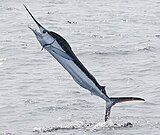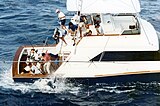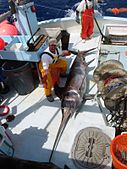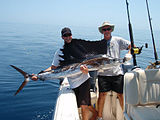Bud N’ Mary’s Adventures
By Jan S. MaizlerArticle & Travel EditorPhotos By Jan S. Maizler and Ron Modra
Time and Tide
 It seemed like ages since I’d been to Bud N’ Mary’s. From where I stand now, looking back over proverbial oceans of time I recall being poled across the flats of Flamingo by Captain Joe Stephens in search of redfish records on 4-pound spin for the International Spin Fishing Association. During the cold weather, Captain Roger Martin would take us back to fish the potholes of Snake Bight for snook using plug tackle and red and white Millie’s bucktails. I also remember running out for early morning bonefish with Captain Earl Gentry. All of this frenetic activity clustered around all my available weekends in the early seventies. Little did the teenager who streaked down the Overseas Highway in his Firebird 400 realize he would morph into a Boomer with a Pathfinder S.U.V.
It seemed like ages since I’d been to Bud N’ Mary’s. From where I stand now, looking back over proverbial oceans of time I recall being poled across the flats of Flamingo by Captain Joe Stephens in search of redfish records on 4-pound spin for the International Spin Fishing Association. During the cold weather, Captain Roger Martin would take us back to fish the potholes of Snake Bight for snook using plug tackle and red and white Millie’s bucktails. I also remember running out for early morning bonefish with Captain Earl Gentry. All of this frenetic activity clustered around all my available weekends in the early seventies. Little did the teenager who streaked down the Overseas Highway in his Firebird 400 realize he would morph into a Boomer with a Pathfinder S.U.V.As my writing career grew, many angling travel stories cropped up and took me out of Florida as well as the States for long stretches of years. Back in the Keys, and Islamorada, people came and went, some of them died, and buildings and ventures went up or down. But amazingly, Bud N’ Mary’s not only stayed and prevailed- it also prospered and became the heartbeat of sport fishing in the Keys. No, indeed, this remarkable place did not pass into history: rather, it became a living legend and Grail for the best game fish in Florida. Not bad for an angling institution established in 1944!
So my return to Bud N’ Mary’s was like coming home again to all the forgotten magic in a place not far at all from Miami’s “backyard.”
A Simple Yet Inspired Plan
I made my initial contact with Captain Rick Stancyzk, whom I had gotten to know from his excellent reports on CyberAngler. Rick’s range of operation was from Flamingo and the Gulf banks out to the Atlantic patches. Our plan was to fish his bayboat on the Sprigger Bank area one day and the Oceanside patches on the ‘morrow. As our target weekend unfolded, the three-day forecast called for 25 M.P.H. northeast winds. Rick’s father, Bud N’ Mary’s owner Richard Stancyzk suggested we use their 34-foot charter vessel, which would make trips on these blowy days do-able. I was delighted!Day #1
 After a quick jaunt from Miami, I went to the office to meet Rick, only to find out that we’d be joined by some illustrious colleagues. I walked out to the end of the skiff pier towards the vessel and was introduced to Keys icon Captain Richard (senior), ace photographer Ron Modra and North Carolina offshore Captain Dave Peck.
After a quick jaunt from Miami, I went to the office to meet Rick, only to find out that we’d be joined by some illustrious colleagues. I walked out to the end of the skiff pier towards the vessel and was introduced to Keys icon Captain Richard (senior), ace photographer Ron Modra and North Carolina offshore Captain Dave Peck.As we cast off lines, Richard said we’d have plenty of time to talk since the run to Sprigger Bank in the bigger boat was around one and a half hours. And, indeed, we did converse. I spent the largest bulk of the “cruise” talking with Richard. It quickly emerged that although we had not formally met until now; our paths had crossed very closely over the last four decades. I found it fascinating how many people we had mutually known or fished with. As Richard piloted our vessel from the shallow Atlantic through one of the Overseas Highway bridges and westward into the wind-tossed green Gulf, he told me many tales that made the past come alive in a personally compelling way. As I listened, Richard’s recollections made me think of the old Florida Keys and its’ passel of Damon Runyonesque characters- all wrapped in a reel of the Fox Movietone News. We even talked and mused over the possible cosmic forces that move fish- both alone and in schools.
As we finally reached our area, Richard started focusing on certain honeyholes stored in his GPS- yet all of them were covered over with dirty turbid water being rumpled and blown by bad-intentioned northeast winds gusting to 30 MPH. This forced a trio Pow Wow (Richard, Rick, Dave) as to which kind of turbid water we’d have to settle for. It emerged that the dirty green sandy water over some of our spots was preferable to the yellowish muddy water that lay to the north.
Prior to anchoring, Richard told Dave to deploy a chum bag hung over the stern. When this was accomplished, Richard slow-trolled the scent and tiny chunks all around the area to fire up the game fish. After we accomplished a very carefully-placed anchoring, another chum bag was deployed. Ron and Rick grabbed spinners rigged with wire leaders and either a bare hook or a jig head. They hooked large live shrimp to these items and tossed them into the water not far from the stern. Dave started casting a spinner rigged with a wire leader and a jig. I stuck with one of my plug rods rigged with a 40-pound fluorocarbon leader and a white 3/8 ounce Spro jig. Both of us worked waters much further astern than the baited rigs.
Within minutes the action started coming. First, a nice bluefish by Dave. Then I caught a fat seatrout. Then both Ron and Rick hooked up with fat Spanish mackerel. I hung a small piece of fresh shrimp to my jig and flung it way back. Then I let it settle into the bottom 20 feet below. On the second sweep of the rod, I had a blast of a strike and two minutes later, I was lifting a big pompano into the cockpit.
This was the way it went for the four hours we fished. At times, there might be a lull in the action. But after a few jerks of the chum bags, the fish went nuts again. Rick also caught and released a 150-pound goliath grouper after chumming and baiting with some huge mackerel chunks. The day could best be described as joyous pandemonium.
Day #2
 The next day was just as windy. Our ride to the patches would be much shorter, but also on the windward side. Today, the captain and crew were somewhat different. Captain Dave would be running the boat and captain Rick would be the first mate. Joining me for fishing was Rick’s friend, Elizabeth Baxter, and Dave’s friend, Ron.
The next day was just as windy. Our ride to the patches would be much shorter, but also on the windward side. Today, the captain and crew were somewhat different. Captain Dave would be running the boat and captain Rick would be the first mate. Joining me for fishing was Rick’s friend, Elizabeth Baxter, and Dave’s friend, Ron.The ride out was rough, despite the size of the vessel. We finally made it to the outside patches, but the waves towered at over five feet and made anchoring impossible as well as possibly unsafe. Captain Dave quickly decided to fish some patches inshore where it was slightly less rough. After locating our honeyhole on the GPS, it took three tries plus a huge amount of rode to keep us anchored in our spot.
Since the bottom was much harder than the Gulf, the ocean water was dirty, but opaque enough to be definitely fishable. The same chumming techniques and fishing rigs were deployed. And the action was immediate. A partial list of the fish we caught were yellowtails, mutton snappers, mangrove snappers, red groupers, gag groupers, hogfish, amberjacks, yellow jacks, as well as loads of smaller reef species.
In about two hours, I’d counted over a hundred fish caught and released. Since I had my pictures and certainly my story, I told Dave we could “pack it in” in the increasingly larger waves. While I mused over our two-day success, the word came in that the Stancyzk family was doing quite well in the sailfish tournament that was going on offshore of us. In all these winds, the spindlebeaks were hitting like crazy- no doubt, many release flags would be flying and flapping at the dock later that afternoon.
Bud N’ Mary’s
The offerings and services for boaters and anglers are diverse, comprehensive and complete. Anglers without boats, visitors, tourists, and travelers will find the following offerings: a party boat, rental boats, approximately fourteen offshore charter boats, and twenty four “backcountry” skiff guides. Even anglers bringing their own boats should fish with these captains to safely learn these prolific waters as well as get a lifetime of angling education in one or two charters. The charters cover an enormous swath of habitat including the Flamingo area, Florida Bay, the Gulf “Banks”, the flats of the Keys themselves, and the Atlantic Ocean starting from the shoreline out to thousands of feet of cobalt-blue water. Every game fish in the Keys can be targeted out of Bud N’ Mary’s.
Anglers without boats, visitors, tourists, and travelers will find the following offerings: a party boat, rental boats, approximately fourteen offshore charter boats, and twenty four “backcountry” skiff guides. Even anglers bringing their own boats should fish with these captains to safely learn these prolific waters as well as get a lifetime of angling education in one or two charters. The charters cover an enormous swath of habitat including the Flamingo area, Florida Bay, the Gulf “Banks”, the flats of the Keys themselves, and the Atlantic Ocean starting from the shoreline out to thousands of feet of cobalt-blue water. Every game fish in the Keys can be targeted out of Bud N’ Mary’s.Private boat owners will be pleased to know that in and out dry storage is available via forklift for boats up to thirty feet. In addition, in-water slips are available as well. Inquire first with management to be sure a space or vacancy is available.
This marvelous destination is more than a fishing marina- it’s a resort as well. There is a delightful spread of lodgings which include an efficiency, standard motel rooms, a penthouse, an oceanfront house, and a houseboat. There’s an excellent deli-style restaurant/café that will please you with good “home-style” sandwiches and meals from 6 a.m. to 2.p.m. Check out their fishing shop for some nice apparel and perhaps get outfitted with some dive gear and arrange a diving charter out to the gorgeous reefs.
Contact Data
Captains Richard Stancyzk and Rick StancyzkBud N’ Mary’s Fishing Marina
Mile Marker 79.8 Oceanside
Islamorada, Florida Keys
Phone: 305-664-2461
Toll-Free: 800-742-7945
Web Site: http://www.budnmarys.com/
Email: bnmfm@budnmarys.com
Article Source: http://www.cyberangler.com/




















